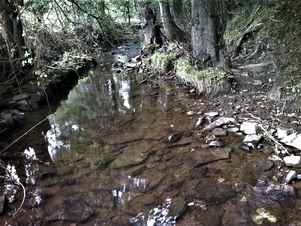

Biodiversity
Action
Plan
White-clawed Crayfish is our only native freshwater crayfish and our largest freshwater invertebrate. Once common and widespread in streams, ponds and lakes, it is under threat from alien invasive crayfish species. Populations of White-clawed Crayfish have already been lost and most of those remaining are at risk of extinction.
White-clawed Crayfish grow to about 10–12 cm in length whereas the invasive Signal Crayfish, an American species, grow to about 16 -18 cm. The smaller native species is dark greenish brown, getting its name from the pale undersides to its claws; Signal Crayfish have a red underside to their claws.
Crayfish live in both flowing and still water, and are usually found in streams with stony beds. They can live in water with some sediment. Crayfish are active mainly at night, hiding by day under stones or in crevices in the riverbank.
They take about six years to reach full size, but breed after three or four years. They mate in October/November, with eggs hatching the following May or June.
White-clawed Crayfish require good water quality to support their prey species – insect larvae and fish. They also feed on larger plants and detritus. They benefit from gravel-bottomed or pebbled stream beds. They live under larger stones, in undermined, overhanging banks, amongst stonework, roots of woody vegetation, saturated logs and accumulations of fallen leaves.
In Barnsley, White-clawed Crayfish have still been found in recent years in Cawthorne Dyke / Daking Brook, a tributary to the river Dearne. Another White-clawed Crayfish population has been recorded in Bretton Lake (the border of Barnsley goes through the lake).
However Signal Crayfish are extending their range threatening the existence of the native crayfish populations: the population in Bretton Lake may already have been wiped out and it is likely that the population in the upper reaches of the Daking Brook catchment will die out unless Research & Development catches up very quickly.
Follow the links below for further information
Priority species
White-clawed crayfish Austropotamobius pallipes, ‘endangered’ on the IUCN red list of threatened species, is at risk of global extinction
It is a Priority Species in the 2007 UK Biodiversity Action Plan.
It is a species of principal importance under Section 41 of the NERC Act (2006).and a Biodiversity 2020 priority species
As a Section 41 species under the NERC Act (2006), White-clawed Crayfish are to be taken into consideration by public bodies in managing their estate.
Local surveys have shown a continued decline in the numbers of White-clawed Crayfish and loss from streams where they were previously. Signal Crayfish continue to extend their range.
It is a Local Priority Species because of its national status, its severe decline, and the risk of its loss to Barnsley.
It is illegal to catch or handle native or non-native crayfish without a licence.
White-clawed Crayfish


Cawthorne Dyke/Daking Brook catchment has supported native White-clawed Crayfish for a century or more. It remains a good crayfish habitat but the native species is under increasing threat from invasive crayfish.
Daking Brook near A635 bridge